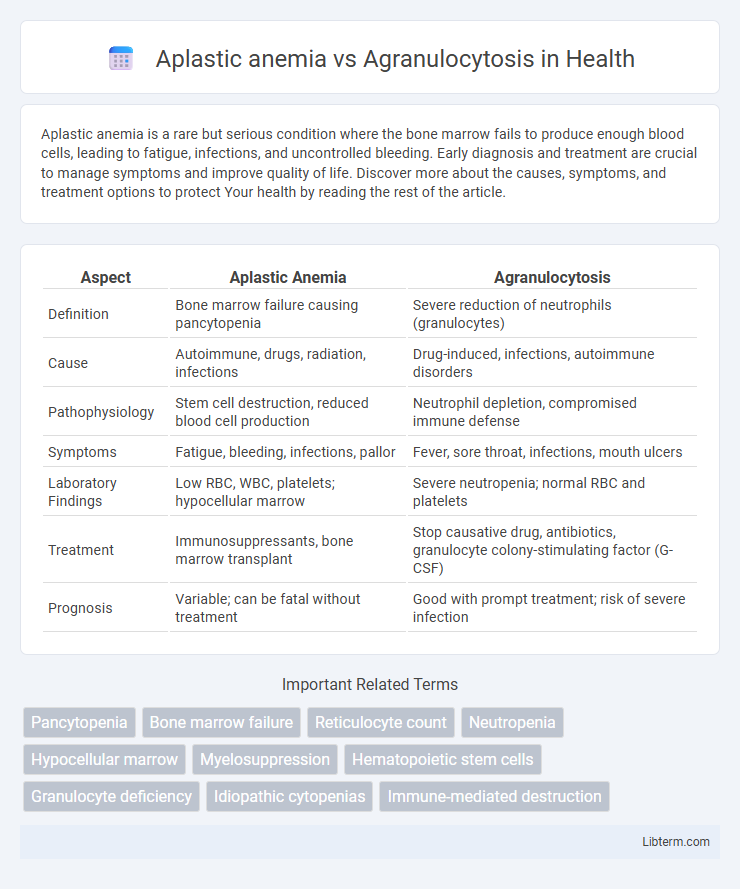Aplastic anemia is a rare but serious condition where the bone marrow fails to produce enough blood cells, leading to fatigue, infections, and uncontrolled bleeding. Early diagnosis and treatment are crucial to manage symptoms and improve quality of life. Discover more about the causes, symptoms, and treatment options to protect Your health by reading the rest of the article.
Table of Comparison
| Aspect | Aplastic Anemia | Agranulocytosis |
|---|---|---|
| Definition | Bone marrow failure causing pancytopenia | Severe reduction of neutrophils (granulocytes) |
| Cause | Autoimmune, drugs, radiation, infections | Drug-induced, infections, autoimmune disorders |
| Pathophysiology | Stem cell destruction, reduced blood cell production | Neutrophil depletion, compromised immune defense |
| Symptoms | Fatigue, bleeding, infections, pallor | Fever, sore throat, infections, mouth ulcers |
| Laboratory Findings | Low RBC, WBC, platelets; hypocellular marrow | Severe neutropenia; normal RBC and platelets |
| Treatment | Immunosuppressants, bone marrow transplant | Stop causative drug, antibiotics, granulocyte colony-stimulating factor (G-CSF) |
| Prognosis | Variable; can be fatal without treatment | Good with prompt treatment; risk of severe infection |
Introduction to Aplastic Anemia and Agranulocytosis
Aplastic anemia is a rare but serious disorder characterized by the bone marrow's inability to produce sufficient blood cells, leading to pancytopenia and increased risk of infections and bleeding. Agranulocytosis specifically involves a severe reduction in granulocytes, particularly neutrophils, causing heightened vulnerability to bacterial infections. Both conditions result from bone marrow failure but differ in their hematologic impact and underlying pathophysiology.
Definition and Key Differences
Aplastic anemia is a rare hematologic condition characterized by the bone marrow's failure to produce sufficient red blood cells, white blood cells, and platelets, leading to pancytopenia. Agranulocytosis specifically refers to an acute deficiency of granulocytes, especially neutrophils, resulting in heightened susceptibility to infections. The key differences lie in aplastic anemia's broad marrow failure affecting all blood cell lines versus agranulocytosis's targeted neutrophil depletion.
Causes and Risk Factors
Aplastic anemia is primarily caused by autoimmune disorders, exposure to toxic chemicals, radiation, certain medications, and viral infections such as hepatitis, leading to bone marrow failure and decreased production of red cells, white cells, and platelets. Agranulocytosis results mainly from drug-induced reactions, particularly antibiotics, antithyroid medications, and chemotherapy, causing a severe reduction in neutrophils and increasing susceptibility to infections. Risk factors for aplastic anemia include inherited genetic mutations and environmental toxin exposure, while agranulocytosis is closely linked to adverse drug reactions and autoimmune conditions.
Pathophysiology Comparison
Aplastic anemia results from the failure of hematopoietic stem cells in the bone marrow leading to pancytopenia, characterized by a deficiency of red blood cells, white blood cells, and platelets. Agranulocytosis specifically involves a severe reduction in granulocytes, especially neutrophils, due to bone marrow suppression or destruction caused by drugs, toxins, or autoimmune processes. The key pathophysiological difference lies in aplastic anemia affecting all marrow lineages resulting in global marrow aplasia, whereas agranulocytosis selectively affects granulocytic precursors, compromising the innate immune defense against infections.
Clinical Manifestations
Aplastic anemia clinically manifests with symptoms of pancytopenia including fatigue, pallor, and increased susceptibility to infections due to reduced red cells, white cells, and platelets. Agranulocytosis primarily presents with severe neutropenia, leading to frequent, severe infections, fever, and sore throat without significant anemia or thrombocytopenia. Bone marrow biopsy in aplastic anemia shows hypocellularity, whereas agranulocytosis reveals marked granulocyte depletion with preserved erythroid and megakaryocyte lines.
Diagnostic Criteria and Laboratory Findings
Aplastic anemia is characterized by pancytopenia with a hypocellular bone marrow, evidenced by a reduction in all three blood cell lines--red cells, white cells, and platelets--while agranulocytosis specifically shows severe neutropenia with less than 500 neutrophils/mL and often a normal or hypercellular bone marrow lacking granulocyte precursors. Diagnostic criteria for aplastic anemia include bone marrow cellularity of less than 25%, reticulocyte count below 1%, and absence of fibrosis or malignant infiltration, whereas agranulocytosis diagnosis is confirmed by pronounced neutropenia and clinical signs of infection. Laboratory findings reveal aplastic anemia presents with pancytopenia and low reticulocyte counts, whereas agranulocytosis primarily involves isolated neutropenia with normal platelet and red cell counts.
Treatment Approaches
Aplastic anemia treatment primarily involves immunosuppressive therapy with agents such as antithymocyte globulin (ATG) and cyclosporine, alongside hematopoietic stem cell transplantation for eligible patients. Agranulocytosis often requires immediate cessation of causative drugs, broad-spectrum antibiotics to prevent or treat infections, and administration of granulocyte colony-stimulating factor (G-CSF) to stimulate neutrophil production. Both conditions necessitate careful monitoring of blood counts and supportive care tailored to severity and underlying etiology.
Prognosis and Outcomes
Aplastic anemia prognosis depends on severity, with severe cases having a higher risk of fatal infections and bleeding, potentially requiring bone marrow transplantation for improved outcomes. Agranulocytosis typically has a more acute onset with a high risk of severe infections due to profound neutropenia, but it often resolves with prompt removal of the causative agent and granulocyte colony-stimulating factor (G-CSF) therapy. Long-term outcomes in aplastic anemia vary widely, whereas agranulocytosis generally has a better prognosis if identified and treated early.
Common Complications
Aplastic anemia often leads to complications such as severe infections, bleeding due to thrombocytopenia, and fatigue from anemia. Agranulocytosis primarily results in recurrent, life-threatening bacterial infections caused by a drastic reduction in neutrophils. Both conditions significantly impair the immune system, increasing vulnerability to opportunistic infections and sepsis.
Summary Table: Aplastic Anemia vs Agranulocytosis
Aplastic anemia is characterized by pancytopenia and hypocellular bone marrow due to marrow failure, whereas agranulocytosis primarily involves severe neutropenia resulting from granulocyte depletion. Key diagnostic differences include bone marrow biopsy findings: hypocellularity in aplastic anemia versus granulocyte-specific suppression in agranulocytosis. Clinically, aplastic anemia presents with symptoms of anemia, infection, and bleeding, while agranulocytosis mainly manifests through increased susceptibility to bacterial infections.
Aplastic anemia Infographic

 libterm.com
libterm.com